|
|
Chorale Melodies used in Bach's Vocal Works
Erbarm dich mein, o Herre Gott |
|
Melody & Text | Use of the CM by Bach | Use of the CM by other composers |
| |
|
Melody & Text: |
|
The hymn, “Erbarm’ dich mein, O Herre Gott,” a translation of Psalm 51, was published in the Enchiridion Oder eyn Handbuchlein (Erfurt, 1524) and in Johann Walter’s Wittenberg Hymn-book in the same year, in the latter with the melody supra. The author of the hymn, Erhart Hegenwalt, appears to have been a student and graduate of Wittenberg and a contemporary of Martin Luther and J. Walter there. The melody is reminiscent of “Es woll’ uns Gott” and is with great probability J. Walter’s composition. J.S. Bach uses it in the Organ movement infra and there is a four-part setting of it among the Choralgesange, No. 78. His text, like Witt’s (No. 258), closely follows the original.
Source: Charles Sanford Terry: Johann Sebastian Bach, Bach’s Chorals, vol. 3 The Hymns and Hymn Melodies of the Organ Works (1921), pp 48, 143-145 |
|
Erbarm dich mein, O Herre Gott. Psalm LI. First published on a broadsheet dated "Wittenberg freytag nach Epiphanie im 1524 Jar. Erhart Hegenwalt." Thence in Eyn Enchiridion, Erfurt, 1524, Wackernagel, iii. p. 48, the Unverfälscher Liedersegen, 1851, No. 366, &c, in 5 stanzas. of 8 lines. Translated as: (1) "O God, be mercyfull to me," by Bp. Coverdale, 1539 (Remains, 1846, p. 576). (2) "Shew pity, Lord! O Lord forgive," by J. C. Jacobi, 1722, p. 59 (1732, p. 95), and as No. 120 in pt. i. of the Moravian Hymn Book, 1754. Jacobi borrows a good many lines from Isaac Watts's version of Ps. li. [Rev. James Mearns, M.A.]
Source: Hymnary.org |
|
One the designated hymns for Reminiscere in the NLGB is the Erhart Hegenwalt (16th c.) paraphrase setting of Penitential Psalm 51, "Erbarm dich mein, o Herre Gott, nach deiner großen Barmherzigkeit" (Have pity on me, O Lord God, according to thy great mercy). It was published in 1524 in the Erfurt Enchiridion, set to the Johann Walter? melody (Zahn 5851, http://imslp.org/wiki/Erbarm_dich_mein%2C_o_Herre_Gott_(Walter%2C_Johann)), as a five eight-line stanza Bar form liturgical Psalm hymn texts (http://matthaeusglyptes.blogspot.com/2009/11/erbarm-dich-mein-o-herre-gott.html). E. Hegenwalt was a student at Wittenberg University and his hymn was known by Martin Luther. The melody is reminiscent of "Es woll' uns Gott genädig sein" May God be gracious to us," the M. Luther/Matthias Greiter 1524 hymn, says Charles S. Terry. It is found in the NLGB as No. 256 (Psalm Hymn), also designated hymn for the Sundays in Trinity 3, 11, 14, and 22). It is listed in the Orgelbüchlein as No. 68 (Passiontide, Peintence), source Witt's Gotha Hymnal 1715, No. 258, but not set. It is found in Schmelli No. 70, Repentance Song.
Besides the aria "Erbarme dich, mein Gott" in the St. Matthew Passion (https://www.youtube.com/watch?v=X_tXqQlFdcQ), Bach set "Erbarm dich mein, o Herre Gott" as an early Miscellaneous chorale, BWV 721 in f-sharp minor (https://www.youtube.com/watch?v=YpEX4YF_NFU), authenticity questioned, says Peter Williams (https://www.classicalarchives.com/work/812141.html), and a plain chorale, BWV 305 in e minor (http://www.bach-chorales.com/BWV0305.htm, https://www.youtube.com/watch?v=zhPC2G8_9eM).
Source: 2nd Sunday in Lent, Michael Bach Cantata, Readings, Chorales (William L. Hoffman, March 2, 2018) |
|
Melody: Zahn 5851
Composer: Anon (probably Johann Walter) (Wittenberg, 1524) |
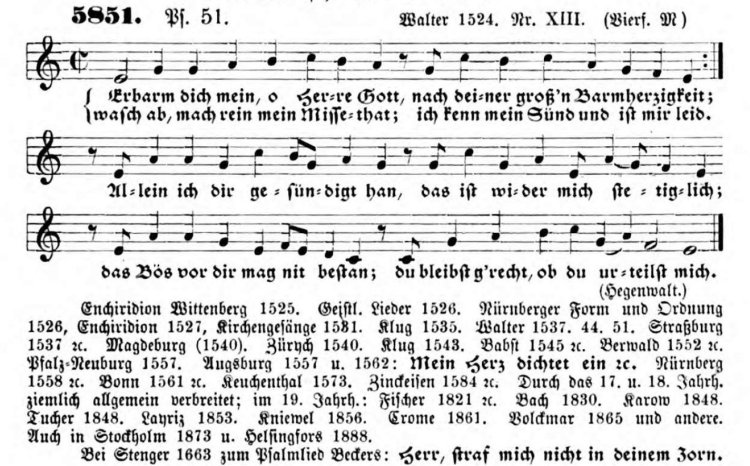 |
|
Text: Erbarm dich mein, o Herre Gott (NLGB 256; OB 68, GH 258)
Author: Erhart Hegenwalt (1524), based on Psalm 51 Miserere mei, Dominus |
|
Hymnal versions Bach may have known: |
|
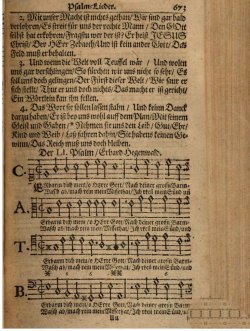
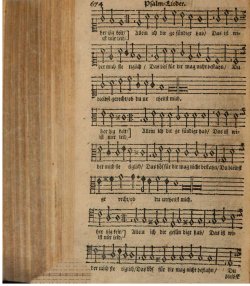
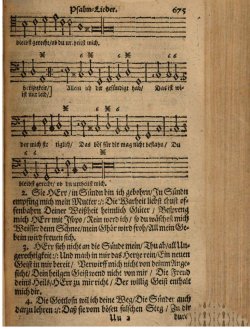
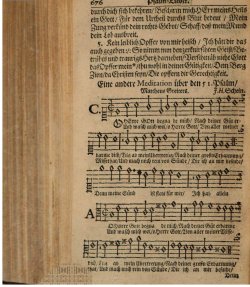
|
|
Melody & text of Das walt’ mein Gott, Vater, Sohn und heiliger Geist (NLGB
256) from the Neu Leipziger Gesangbuch, pp 673-676 |
| |
| |
|
Use of the Chorale Melody by Bach: |
|
Text: Erbarm dich mein, o Herre Gott |
|
Chorale Erbarm dich mein, o Herre Gott, BWV 305
Ref: RE 34; Br 33; KE 78; Birnstiel 37; Levy–Mendelssohn 60; Fasch p.142; BGA 52; BC F55.1; CST 81 |
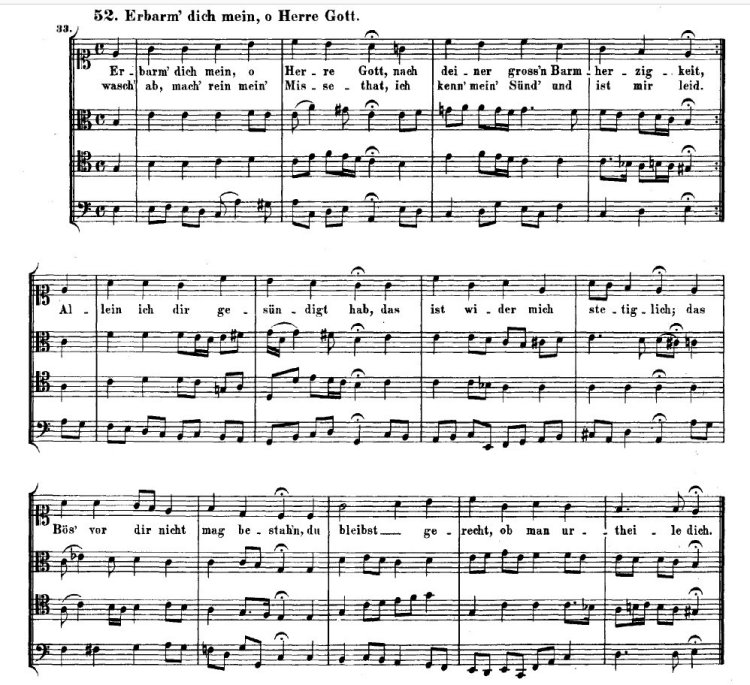 |
|
Untexted: |
|
Chorale Prelude Erbarm dich mein, o Herre Gott, BWV 721 |
|
The cantus is set to an accompaniment unique in J.S. Bach’s Organ music. Spitta finds a counterpart to it in an arrangement of “Vater unser im Himmelreich,” by Georg Böhm, and concludes that J.S. Bach’s movement was composed at Lüneburg under G. Böhm’s immediate influence, at the period in which the Variations upon “Christ, der du bist der helle Tag” were written, i.e. c1701-1702, when J.S. Bach was 16 or 17 years old. On the other hand, Johann Kuhnau (d 1722), J.S. Bach’s predecessor at Leipzig, issued in 1700 six Clavier Sonatas illustrating certain Bible stories. Into the first of them, depicting the fight between David and Goliath, he introduces the melody “Aus tiefer Not” in the right hand against repeated quaver chords in the left. As a young man J.S. Bach probably knew this work. His wistful accompaniment’s congruity to the mood of Erhart Hegenwalt’s hymn is apparent.
The ms. of the movement is in Johann Ludwig Krebs’ Sammelbuch, marked “J. S. B.” |
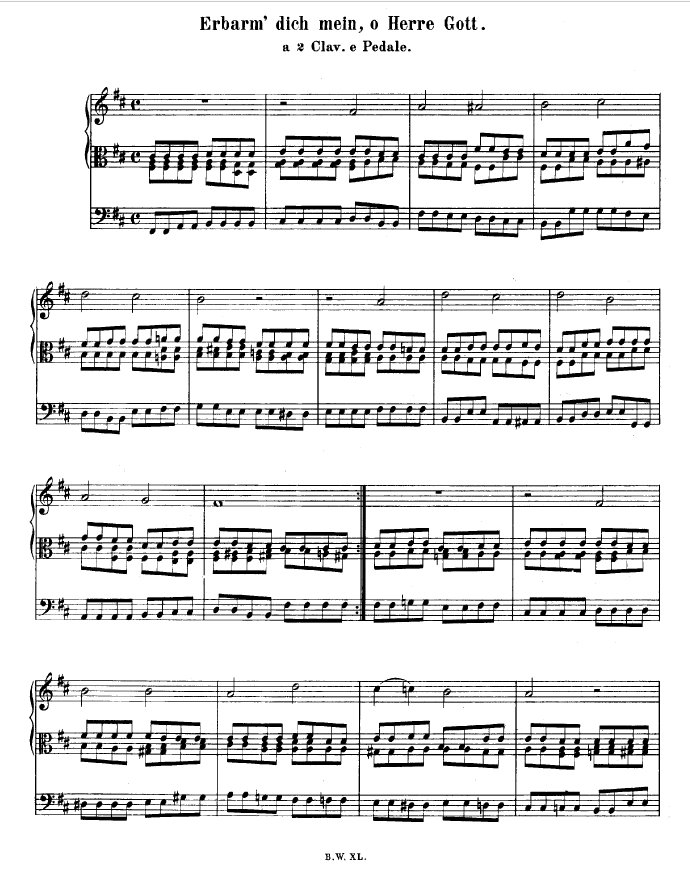 |
| |
| |
|
Use of the Chorale Melody by other composers: |
|
The Neumeister Collection includes a setting of Friedrich Wilhelm Zachow (Thomas 58), No. 76, eschatological hymn (https://www.youtube.com/watch?v=ImFeJrkFqC8, LV 18).
A chorale prelude setting (https://www.youtube.com/watch?v=yVPkWfvPJg4) of Heinrich Bach (1615-1692), father of Johann Michael Bach, may be the work of Johann Heinrich Buttstett, says Karl Geiringer. Johann Christoph Bach (1642-1703), Michael's older brother, composed a set of 44 chorale preludes, including "Erbarm dich mein, o Herre Gott," http://imslp.org/wiki/44_Choräle_zum_Präambulieren_(Bach,_Johann_Christoph). It is known in English as "Show pity, O Lord, Forgive (https://hymnary.org/text/show_pity_lord_o_lord_forgive_is_not).
Two Bach colleagues set the chorale "Erbarm dich mein o Herre Gott": Georg Philipp Telemann in the Missa sopra (Kyrie-Gloria), "Missa Erbarm dich mein o Herre Gott," TWV 9:6, and Christoph Graupner, "Erbarm dich mein o Herre Gott," GWV 1163/24, for the 22nd Sunday after Trinity 1724. G.P. Telemann composed Reminiscere Cantata "Der Reichtum macht allein beglückt," TWV 1:313 (Harmonischer Gottes-Dienst, Hamburg 1726). while C. Graupner composed numerous cantatas for Reminiscere (1712-44, https://en.wikipedia.org/wiki/List_of_cantatas_by_Christoph_Graupner#GWV_1121. Also, Gottfried Heinrich Stölzel composed Reminiscere Cantatas "Er wird sitzen und schmelzen, und das Silber reinigen" (1713), and "Ich danke dir Herr dass du zornig bist gewesen" (1738). The former was part of the "String Cycle," which J.S. Bach presented in 1735-36 and may have been performed on February 26, 1736, possibly in the progressive University Pauliner Kirche or at the New Church.
Source: 2nd Sunday in Lent, Michael Bach Cantata, Readings, Chorales (William L. Hoffman, March 2, 2018) |
| |
| |
|
Sources: Bach Digital; BGA; Zahn
Photos from Gottfried Vopelius Neu Leipziger Gesangbuch (Vopelius 1682), were taken from a digital copy of the book downloaded from Bayerische Staatsbibliothek München. This copy is Out of copyright - non commercial re-use (Europeana Rights).
Prepared by Aryeh Oron (October 2018) |
|
|